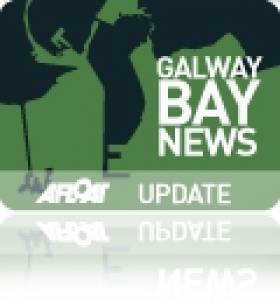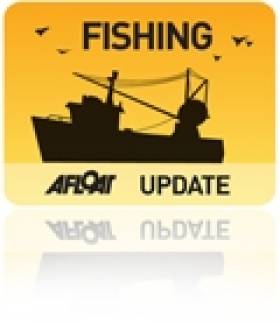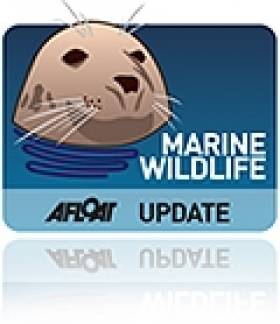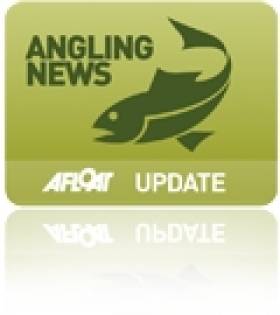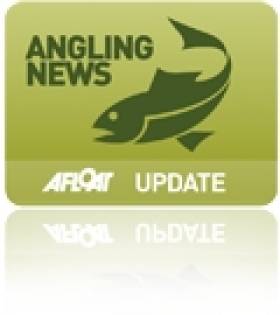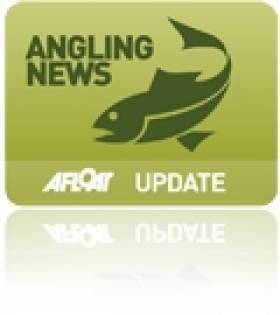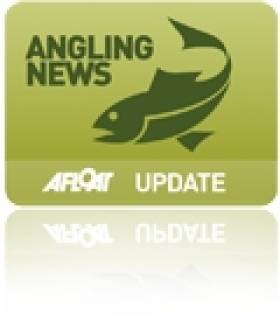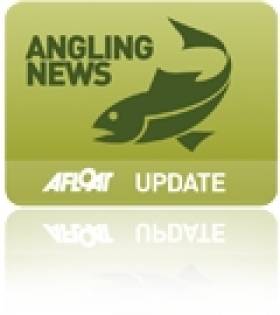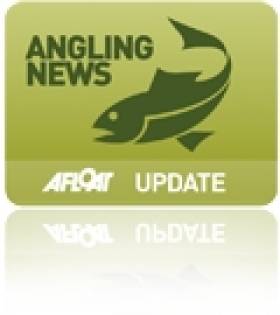Displaying items by tag: Salmon
Six More Months Before Any Decision On Galway Bay Fish Farm
#FishFarm - Any decision on the proposed deep-sea organic salmon farm for Galway Bay is at least six months off, as Galway Bay FM reports.
That was the message from the Department of the Marine after Galway TD Eamon O'Cuiv raised the matter in the Dáil this week.
Previously the Fianna Fáil deputy for Galway West had called on Bord Iascaigh Mhara (BIM) to withdraw its application for the 500-hectare fish farm off Inis Oírr in the Aran Islands in light of dispute over the potential impact of sea lice on the region's wild salmon stocks.
His call, in turn, came after the European Commission halted progress on BIM's plans last November amid concerns regarding scientific studies on the impact of disease at what would be the largest aquaculture scheme of its kind in Europe.
Fish Farm Firm Suspends Harvest Till Weather Improves
#FishFarms - Fish farming has been suspended by one of Ireland's largest salmon aquaculture firms due to the current poor weather and effects of warming waters, according to The Irish Times.
In its latest quarterly report, Marine Harvest cited "very challenging" conditions in Irish waters thanks to last summer's high sea temperatures, which in turn have resulted in a big rise in jellyfish numbers.
And the situation has been exacerbated by "the most consistently stormy period since Marine Harvest Ireland began farming in Ireland in 1979" that have also wreaked havoc for coastal shellfish farms.
The conditioons have preventing access to coastal fish farming sites, according to the firm's technical manager Catherine McManus, who said operations are expected to resume later this month.
The Irish Times has more on the story HERE.
#MarineWildlife - Inland Fisheries Ireland (IFI) funded the Coastal and Marine Research Centre (CMRC) and University College Cork, in conjunction with partners in UCC's School of Biology, Ecology and Environmental Science (BEES) and the Marine Institute to undertake a two-year pilot study to investigate seal predation on salmon stocks in the Moy and Slaney estuaries.
In the study, which began in August 2011 and continued to August 2013, salmonids were found in the diet of both grey and harbour seals using identification of salmonid bones recovered from the scat (faeces) of seals collected at seal haulout sites in the Moy and Slaney.
Salmonids were recovered in relatively low numbers, representing only 1.6% of the total prey numbers in the Slaney in Co Wexford and less than 5% in the Moy in Co Sligo. But due to the large size of individual salmonids, they comprised approximately 15% of the total prey biomass consumed.
The presence of salmonids in the diet of seals is likely to represent consumption of both salmon (Salmo salar) and sea trout (Salmo trutta), with contribution to the diet related to seasonal abundance.
Genetic techniques were employed to confirm salmonid species identification based on hard structures, with both salmon and sea trout DNA being detected in scats.
The removal of salmonids by seals, or other predators, must be placed into context of the amount removed by fisheries. In the Moy, 6,564 salmon were caught (non-release) by rod fisheries (five-year average, P Gargan IFI pers comm) which is likely to be far higher than that removed by seals in the area.
However, smaller salmon population units are most vulnerable to predation, and even low levels of predation by 'specialist' seals (or other predators) could have disproportionately large effects on small salmon population units such as in the Slaney.
The full report is available to download as a 4.3MB PDF file HERE.
Wild Salmon Fishery Bye-Laws 2014 Approved
#salmon – The Government has approved a suite of regulations and bye-laws that will govern the wild salmon fishery in 2014. These will come into effect from Tuesday 1 January 2014.
Minister O'Dowd at the Department of Communications, Energy and Natural Resources said "I am pleased to note that 87 rivers will open for angling activity in 2014. Fifty seven rivers will be fully open while a further 30 will be open for angling on a "catch & release" basis. This will provide opportunities for commercial fishermen and anglers to share this important resource on a sustainable basis."
"In 2012 I lowered the cost of fishing licences and I have decided to maintain that price cut for 2014. I am anxious that lower costs will encourage sales of annual licences and incentivise angling tourists to avail of the Ireland's first-class angling product", he added.
Minister O Dowd received management and scientific advice on the current status of Irish salmon stocks from Inland Fisheries Ireland and considered submissions received through the public consultation exercise. Based on this he has introduced conservation measures for the management of the wild salmon and sea trout fishery in 2014.
In all, the Independent Standing Scientific Committee for Salmon (SSCE) assessed 143 rivers and have advised that:-
· 57 rivers are open as a surplus of fish has been identified in these rivers;
· 30 rivers have been classified as open for angling on a "catch and release" basis only; and
· 56 rivers are closed as they have no surplus of fish available for harvest in them.
The Wild Salmon and Sea Trout Tagging Scheme Regulations for 2014 are in essence unchanged from the Regulations which were introduced for 2013. A number of minor amendments to the Regulations, recommended by Inland Fisheries Ireland, will provide for more effective administration of the tagging scheme regulations in 2014.
Summary of main changes to the management of the wild salmon fishery in 2014
3 Rivers which were closed in 2013 will open for "catch & release" in 2014
Clonee (Kerry Fishery District), Owenagarney (Limerick Fishery District), Skivaleen (Limericky Fishery District),
4 Rivers which were open in 2013 will be "catch & release" in 2014
Suir (Waterford Fishery District), Owenmore (Kerry Fishery District), Owenwee (Ballyshannon Fishery District), Owenmore (Bangor Fishery District)
6 Rivers which were open for "catch & release" in 2013 will open for harvest in 2014
Screebe (Connemara Fishery District), Bunowen (Ballinakill Fishery District), Owenwee Belclare (Ballinakill Fishery District), Glyde (Dundalk Fishery District), Argideen ( Cork Fishery District), Sheen (Kerry Fishery District)
1 River which was open for catch and release in 2013 will close in 2014
Owenavorragh (Wexford Fishery District)
Wild Salmon and Sea Trout Tagging Scheme Regulations, 2013 for the 2014 season provide for, among other things, the total allowable catch of fish that can be harvested by commercial fishing engines and rod and line from identified rivers.
Conservation of Salmon and Sea trout (bag limits) Bye-law No. 915, 2013 provides for an annual bag limit of 10 fish being either salmon or sea trout (over 40 cm) per angler and provides for a season bag limit of 3 fish in the period 1 January to 11 May, a daily bag limit of 3 fish from 12 May to 31 August and a daily bag limit of 1 fish from 1 September to the end of the season. The Bye-law also provides for the use of single barbless hooks and prohibits the use of worms as bait once the specified number of fish have been caught in the specified periods.
Conservation of Salmon and Sea trout (catch and release) Bye-law No. 914, 2013 provides for catch and release in respect of salmon and sea trout (over 40 cm) in rivers that are meeting at least 65% of their Conservation Limit as mentioned in the Bye-law. The Bye-law also provides for the use of single barbless hooks and prohibits the use of worms as bait in angling for salmon and sea trout over 40 cm.
Conservation of Salmon and Sea trout (closed rivers) Bye-law No. C.S. 316, 2013 prohibits the taking or attempting to take by rod and line salmon and sea trout over 40 cm in the rivers specified in the Bye-law.
Angling Byelaw 913, 2013
This Bye-law prohibits the use of any fish hooks, other than single barbless hooks, and also prohibits the use of worms as bait in angling for all species of fish in the waters specified in the Bye-law and revokes Angling Bye-law No. 907, 2013.
Conservation of Sea Trout Bye-law 916, 2013
This Bye-Law provides for a daily bag limit of 3 sea trout (less than 40 cm in length) and provides for the use of single barbless hooks and prohibits the use of worms as bait once the specified number of sea trout have been caught.
Catch-And-Release Christmas On Select Salmon Fisheries
#Angling - Christmas Day will see an early start to the new salmon angling season on a select number of fisheries.
As Derek Evans writes in The Irish Times, the early fisheries include the Lower Liffey - from Islandbridge to Leixlip Dam - for catch-and-release angling for the second year running.
Elsewhere, it's been announced that Inniscarra Lake in Co Cork will host the World Feeder Fishing Championships next July.
And a new book on Ireland's sea trout fisheries had recently been published.
Nomads of the Tides by Chris McCully and Ken Whelan details 50 different fishing locations with grid references and information on permits and local accommodation which will surely make it a must for angling tourists.
The Irish Times has more on the new book HERE.
Salmon Conservation Fund Contributors Scheme Open To Submissions
#SalmonFund - Angling clubs, commercial fishermen, fishery owners, riparian owners and landowners with an interest in a salmon fishery are invited to submit projects to the Salmon Conservation Fund 2013/14 Contributors Scheme.
An initial fund of €200,000 is available in 2014 for distribution to contributors. Approved project applications may be fully or partly funded. It is envisaged that the fund will be divided between a range of contributors to a guide of €15,000 per project.
The list of what can be funded under the scheme includes:
- Fish passage improvement (eg removal of barriers, modification of weirs, and construction of fish passes, etc)
- Spawning enhancement (addition/raking of gravel or cleaning of existing substrates)
- Instream structures (weirs, deflectors, rubble mats, random boulders, etc)
- River bank protection (rock armour, log revetment etc)
- Fencing (protection of river banks including fences, stiles, cattle drinks, etc)
- Riparian zone improvement (tree pruning and strategic tree planting)
- Removal and control of exotic invasives (eg Rhododendron, Japanese knotweed, Asian clam, chub, etc)
- Feasibility studies (that lead to future projects under the above headings to maximum of 50% funding or €2,000, whichever is less; a maximum of five 5 studies only to be allowed)
For further details on the scheme, how to apply, an application form and more see HERE.
Notice On 2014 Wild Salmon & Sea Trout Tagging Measures
#Angling - Fergus O'Dowd TD, Minister of State at the Department of Communications, Energy and Natural Resources, has given statutory notice of his proposal to revise the Wild Salmon and Sea Trout Tagging Scheme Regulations to apply from 1 January 2014.
The minister proposes to revoke the existing tagging scheme regulations and to make revised regulations to provide for commercial fishing and angling total allowable catches on an individual river basis.
The draft regulations are available HERE and open for public inspection. Any person may submit objections to the draft regulations at any time till 7 December 2013 either by email to [email protected] or in writing addressed to:
Inland Fisheries Division
Department of Communications Energy and Natural Resources
Elm House, Earlsvale Road,
Cavan
European Anglers Call For Tighter Controls On Salmon Farms
#Angling - A resolution passed last week at the general assembly of the European Anglers Alliance (EAA), representing the interests of 3 million recreational anglers across 13 European nations, demands that all farmed Atlantic salmon should be produced in closed or contained farm systems.
The EAA also urges all fish farming nations across Europe to pursue rapid development towards sustainability to reduce the impact on wild salmon populations, and urges policy makers to use the 'precautionary principle' and 'polluter pays principle' to ease the transition towards more environmentally friendly and sustainable salmon farming practices.
According to the lobby group, escaped farmed salmon and sea lice infestations continue to have a devastating impact on wild Atlantic salmon and Europe’s sea trout populations – many of which have seen severe declines, or have been destroyed completely.
So far the focus has been to fish-out escaped farmed salmon, as well as using chemical and biological measures to remove lice in the farms - measures that have unfortunately not solved the problems.
The alliance argues that closed or contained systems, either at sea or on land, would reduce the infestation of sea lice among farmed fish, reduce the risk of farmed fish escaping into the environment and dramatically reduce the damage done by waste, pollutants and chemical residues from disease treatment entering the natural environment.
“It may come as a surprise to most people that in many rivers there are more farmed than wild salmon," said EAA secretary general Jan Kappel. "The escaped farmed fish compete with and genetically pollute our wild salmon stocks. It is well known that sea lice spread from the salmon farms and harm wild salmon stocks.
"To our greatest surprise Norway has banned recreational angling in the Hardangerfjord where salmon stocks have declined due to the impact from extensive salmon farming. This doesn’t make sense. The polluter should be managed before other legitimate and sustainable users like recreational anglers are denied access to what used to be healthy salmon stocks.”
The EAA's comes in the wake of continued controversy over the proposed Galway Bay organic salmon farm, which if green-lighted would be the largest aquaculture facility of its kind in Europe.
Improving Life for Trout and Salmon on Lough Corrib’s Tributaries
#Angling - A recent collaboration between Inland Fisheries Ireland (IFI), angling clubs and private individuals with close links to Lough Corrib is helping to improve matters for trout and salmon stocks in the catchment area.
Over recent years, State funding has been decreasing for habitat improvement and stream rehabilitation work on salmonid spawning and nursery streams. Local angling clubs and concerned individuals have recognised this, and stepped in to assist with funding to ensure this vital work on such a crucial natural resource continues.
A joint initiative between Cairde Loch Coiribe and the Clydagh Foundation has sponsored spawning and nursery rehabilitation projects on a number of Corrib streams.
Cairde Loch Coiribe raises funds from various angling clubs around the lake through the Corrib Federation, while the Clydagh Foundation invests in enhancement projects on the Corrib spawning streams. IFI staff, who have years of expertise in this area, design and supervise the projects.
This important work enhances habitat for spawning adult trout and salmon, and increases the nursery ground available for young fish to grow and mature.
Electro-fishing surveys carried out by IFI before and after similar works have shown that juvenile fish stocks can be increased significantly by such enhancement. It is hoped that these juvenile fish will eventually grow and augment the stocks of fish available for game angling.
Local clubs including Kilbeg, Ballindiff, Headford and Collinamuck have assisted in the most recent projects in their respective areas. Enhancement projects for 2013 have been identified and it is hoped to commence in the coming months.
These projects complement ongoing works by the OPW’s Drainage Division, under its Environmental River Enhancement Programme. This programme is carried out through liaison with IFI to improve fish habitat on previously drained channels.
Tourism angling is a major part of the local economy around Lough Corrib, and it is expected that this work will have tangible economic benefits.
#FishFarm - Bord Iascaigh Mhara (BIM) has responded to concerns from environmental groups that an ingredient in treatments for sea lice in salmon farms poses a threat to wild marine life.
As Galway Bay FM reports, campaigners Galway Bay Against Salmon Cages - one of the groups opposed to the planned Galway Bay fish farm - say that cypermethrin, an active ingredient in veterinary medicine used to treat sea lice, is toxic to aquatic organisms.
BIM aquaculture manager Donal Maguire attempted to play down fears over the use of the pesticide, saying it has been fully tested for toxicology in the marine environment.
However, another campaign group claims BIM's position is contrary to the manufacturer's own warnings on the use of the drug.
According to FishNews.eu, Friends of the Irish Environment (FIE) cited the Irish Medicines Board's product description for cypermethrin, which states that it is "dangerous to fish and other aquatic life" and demands that the chemical "should not be allowed to contaminate water".
FIE went on to describe cypermethrin as "a biocide which kills life, not a medicine that saves lives" and as "a highly active neurotoxin" with "known effects on fish and, most sensitive of all, crustaceans such as crabs and lobsters. Bathers and watersports [enthusiasts] may also be at risk."
Earlier this month, Inland Fisheries Ireland (IFI) expressed "serious concerns" over the findings of a study on wild salmon in Ireland that claimed fish farm schemes were less harmful to wild fish than pollution and possibly even beneficial to wild catchments.
IFI is among the significant opposition to BIM's proposed organic salmon farm off the Aran Islands, a 500-hectare project that would be the largest of its kind in Europe and create hundreds of jobs in the locality.


























